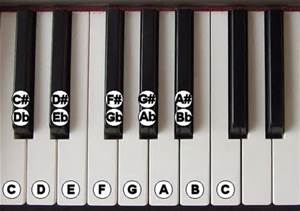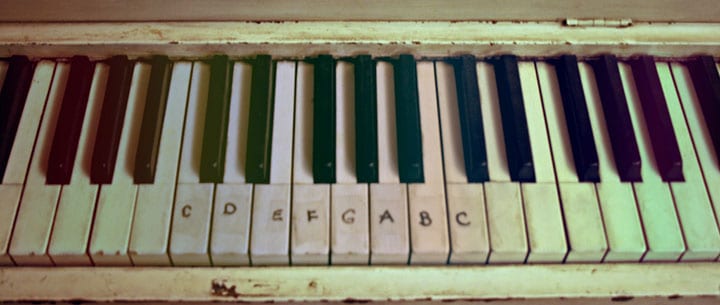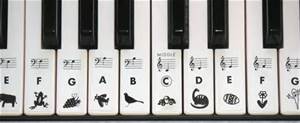Struggling to remember which key is which on the piano? One common learning strategy is to improve your keyboard with labeled keys. Read on as St. Augustine, FL teacher Heather L. shares her thoughts on the method…
Can labeled piano keys help you learn faster? This is a highly controversial topic and hotly debated in the music education world.
Having come from a high-pressure, formal music college, at the beginning of my teaching career I disliked the idea of any labeling for any age, either on the keys or in the sheet music. And I had previously spent years teaching myself music on the piano, labeling notes on the page with their letter names. It would take me forever to learn a piece of music, because the labeling caused me to focus on individual notes instead of larger chunks of music, like chords. As a young piano teacher, I was afraid that beginner piano keys labeled would handicap my students in a similar way. Over the years, however, the non-academic reality of teaching students of all ages and meeting their challenges has set in.
Strong memorization skills are part of a successful piano career. It’s essential to memorize the letter names of all of the piano keys, eventually. In the meantime, though, for young children up to about age 10, for beginning adult students, and for any student who finds him or herself feeling frustrated over which key is which, labeling your piano keys may help you learn faster.
So, how to label piano keys?
My professional opinion is that keyboard keys labeled should be color coded because this is superior to labeling with letter names or with images of a note’s location on the music staff. All three kinds of labeling encourage memorization, but with color coding, the labeling becomes not such a big crutch. You still have to remember other descriptions of the note that you’re reading and playing. For instance, if you label your piano keys with color coding (e.g. green dot stickers on all Gs, red dot stickers on all Cs), you have to remember, still, which color means which letter name. That, in itself, is building memory skills. Labeling with images of a note’s location on the music staff, in my opinion, handicaps a student. It discourages the processing of new information in large chunks. Science has shown that people with the greatest memories memorize in that way, so I’d rather my students learn where all of the Cs are, where all of the Gs are, and so on, and not to focus primarily on where each individual note is on the music staff.
Below is an example of how you can label your keys with letter names on simple, blank circle stickers from any major office supply retailer. What you see here, the letters C through C, should be repeated all the way up the keyboard.

And here is an example of beginner piano keys labeled with images where they are notated on a music staff:
Yet another way to label is to use only certain letter names. For instance, label only Cs, Fs, and A’s, leaving the rest of the piano keys blank. This further encourages memorizing in groups of information.
Finally, with the guidance of a piano teacher, students can be weaned away from the labels by gradually removing them, perhaps two or three every week. Eventually, the notes will be memorized and reading piano music will become much easier.
 Heather L. teaches singing, piano, acting, and more in Saint Augustine, FL, as well as through online lessons. She is a graduate of the prestigious Westminster Choir College in Princeton, New Jersey, and has performed with the New York and Royal Philharmonics, the New Jersey and Virginia Symphonies, the American Boy Choir, and the internationally renowned opera star Andrea Bocelli. Learn more about Heather here!
Heather L. teaches singing, piano, acting, and more in Saint Augustine, FL, as well as through online lessons. She is a graduate of the prestigious Westminster Choir College in Princeton, New Jersey, and has performed with the New York and Royal Philharmonics, the New Jersey and Virginia Symphonies, the American Boy Choir, and the internationally renowned opera star Andrea Bocelli. Learn more about Heather here!Photo by hillarywilliamtanner
Suzy S.



